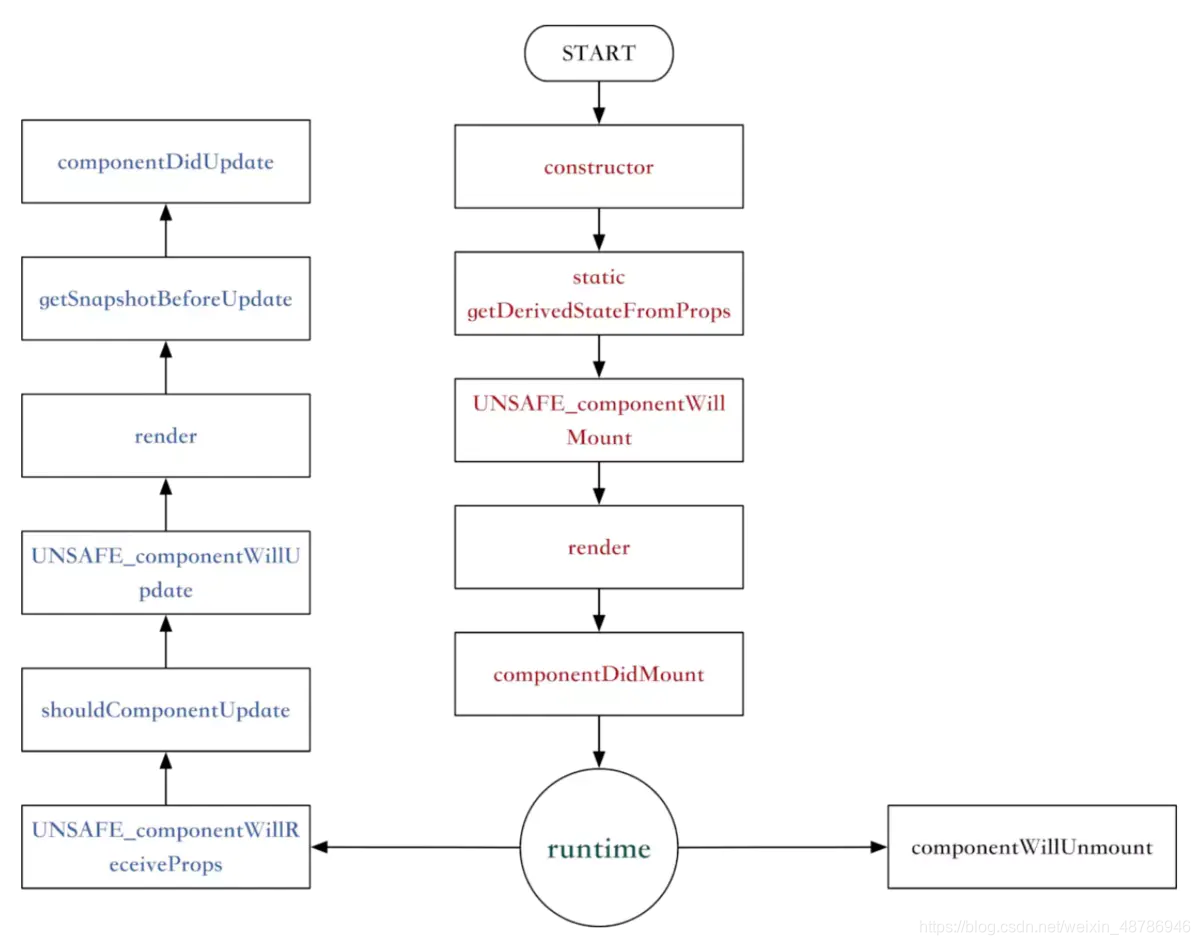react 生命周期可分为四个阶段
- 挂载(mount)——组件在这个阶段被创建然后被插入到 DOM 中;
- 更新(update)——React 组件“成长”;
- 卸载(unmount)——最后阶段;
- 错误处理(error handle)——有时候代码无法运行或某处出现了错误。
react的新的生命周期图:

- 与mounting相关的生命周期方法:
render()
constructor(props)
componentDidMount()
static getDerivedStateFromProps(props, state)
- 与updating相关的:
static getDerivedStateFromProps(props, state)
shouldComponentUpdate(nextProps, nextState)
render()
getSnapshotBeforeUpdate(prevProps, prevState)
componentDidUpdate(prevProps, prevState, snapshot)
- 与unmounting相关的:
componentWillUnmount
- 与error handling相关的:
static getDerivedStateFromError(error)
componentDidCatch(error, info)
1. 挂载生命周期方法
- constructor()
在将组件挂载到 DOM 之前会调用 constructor 方法。通常,你会在 constructor 方法中初始化 state
和绑定事件处理程序。
const MyComponent extends React.Component {
constructor(props) {
super(props)
this.state = {
points: 0
}
this.handlePoints = this.handlePoints.bind(this)
}
}
- static getDerivedStateFromProps()
1.这个生命周期为react新的生命周期函数,
2.这个生命周期的功能实际上就是将传入的props映射到state上面,
3.这个方法在组件被初始挂载到 DOM 之前调用。
4.这个生命周期函数是为了替代componentWillReceiveProps存在的,所以在你需要使用componentWillReceiveProps的时候,就可以考虑使用getDerivedStateFromProps来进行替代了。
5.尽量不使用,维护俩者状态需要消耗额外资源,增加复杂度。
static getDerivedStateFromProps(nextProps, prevState) {
const {type} = nextProps;
// 当传入的type发生变化的时候,更新state
if (type !== prevState.type) {
return {
type,
};
}
// 否则,对于state不进行任何操作
return null;
}
- render()
如果要渲染 DOM 中的元素,可以在 render 方法中编写代码,即返回一些
JSX。你还可以返回纯字符串和数字,如果你不想渲染任何内容,可以在 render 方法中返回一个布尔值或 null。
- componentDidMount()
在调用 render 后,组件被挂载到 DOM,并调用 componentDidMount 方法,只执行一次。 用法:
1.在将组件被挂载到 DOM 之后会立即调用这个函数。
2.在这里可以操作Dom元素,发出ajax请求获取数据。
3.你还可以设置订阅,例如计时器,只需要确保在卸载组件 componentWillUnmount 时取消订阅即可。
2. 更新生命周期方法
- static getDerivedStateFromProps()
- shouldComponentUpdate()
默认情况下,在 props 或者 state 发生变化时都会重新渲染组件,我们在这个方法中返回一个布尔值——true 或
false,用于控制是否重新渲染组件。,达到性能优化的效果。如果 state 和 props 没有发生变更,不希望组件重新渲染,你也可以使用内置的 PureComponent。

- render()
在调用 shouldComponentUpdate 方法后,会立即调用 render——具体取决于
shouldComponentUpdate 返回的值,默认为 true 的时候。
- getSnapshotBeforeUpdate()
使用在render之前调用,state已更新,典型场景:获取render之前的dom状态,getSnapshotBeforeUpdate
生命周期方法本身不会起什么作用,它需要与 componentDidUpdate 生命周期方法结合在一起使用。
3.卸载生命周期方法
- componentWillUnmount()
在卸载和销毁组件之前会调用 componentWillUnmount 生命周期方法。这是进行资源清理最理想的地方,例如清除计时器、取消网络请求或清理componentDidMount() 中创建的任何订阅,
4.错误处理生命周期方法
- static getDerivedStateFromError()
- componentDidCatch()
import React, { Component } from "react";
class ErrorBoundary extends Component {
state = { hasError: false };
static getDerivedStateFromError(error) {
console.log(`Error log from getDerivedStateFromError: ${error}`);
return { hasError: true };
}
componentDidCatch(error, info) {
console.log(`Error log from componentDidCatch: ${error}`);
console.log(info);
}
render() {
return null
}
}
export default ErrorBoundary;